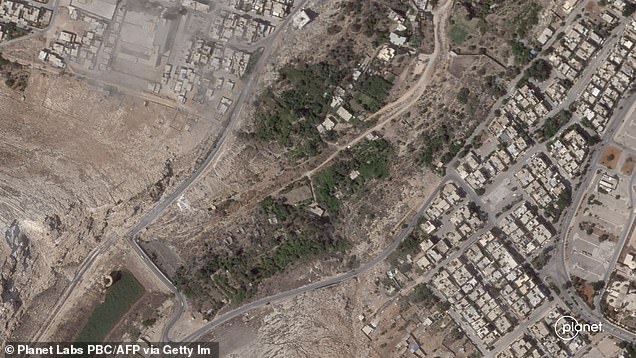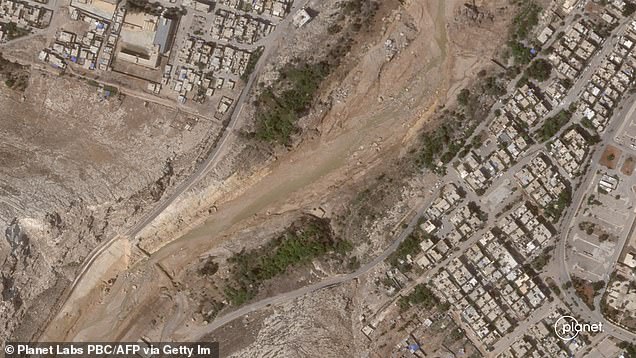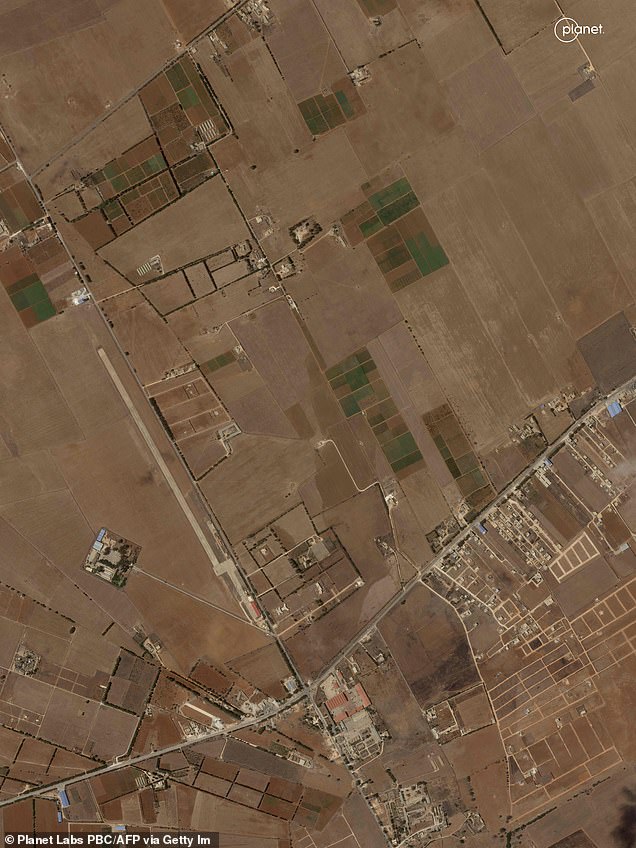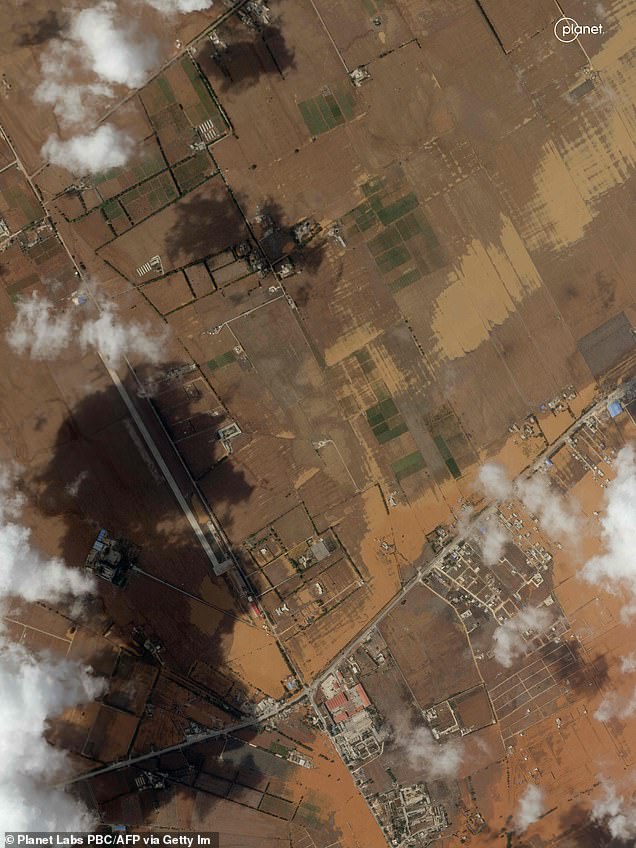Before and after satellite images of Libyan floods reveal the scale of devastation in Derna, where thousands of corpses have been found after whole neighbourhoods were washed away
Catastrophic floods have washed away entire neighborhoods in Libya, satellite images show, with 5,300 people confirmed dead and thousands of bodies found in the eastern city of Derna.
At least 10,000 people are still missing, many of whom are believed to have been swept into the sea by the ‘tsunami-like’ floods, which swept away buildings along with their residents.
Before and after photos reveal the total decimation of Derna and surrounding areas after a powerful storm caused dams to burst, releasing a flood of water that has destroyed a quarter or more of the Mediterranean city.
Pictures have also shown the horrific situation faced by rescuers on the ground, with Libyan Red Crescent volunteers seen plucking the body of a young child from the rubble as his heartbroken father looked on.
Mass graves are now being dug and it is confirmed that 2,000 bodies have been collected. The death toll is expected to rise by the hour as searches of destroyed buildings and the coastline enter their third day.
Before and after photos show the devastation caused by flooding in the Mediterranean city
An aerial view of a dam on the southern outskirts of the city of Derna before and after it burst during the flash floods caused by Storm Daniel
Farmland was completely inundated by the floods near the town of Marj on the outskirts of Derna, destroying houses and crops
Parts of eastern Libya have been hit by the massive floods, with satellite images revealing the extent of the damage.
As the storm raged along the coast on Sunday evening, residents of Derna said they heard loud explosions as the dams outside the city collapsed.
Floods washed away Wadi Derna, a river that flows from the mountains through the city to the sea.
The coastal city, home to about 90,000 people, is normally protected from the waves of the Wadi Derna River, but the burst dams allowed water to flow through.
Aerial photographs of the harbor show buildings being completely washed away, with the river flowing through them completely bursting its banks.
What used to be a relatively narrow waterway through the city center is now many times wider and all the buildings that lined it have disappeared.
The extensive damage, with buildings missing, is also evident in other parts of the city where flooding erupted from the waterway.
The flood caused massive destruction, with cars overturned and mangled and Derna’s streets left covered in rubble, mud and rubble.
The town of Marj, near the city, was also destroyed, with before and after photos of farmland destroyed and still flooded.
The severe damage to one of the dams is also evident in before and after photos, with the surrounding countryside completely destroyed, as well as the settlements below.
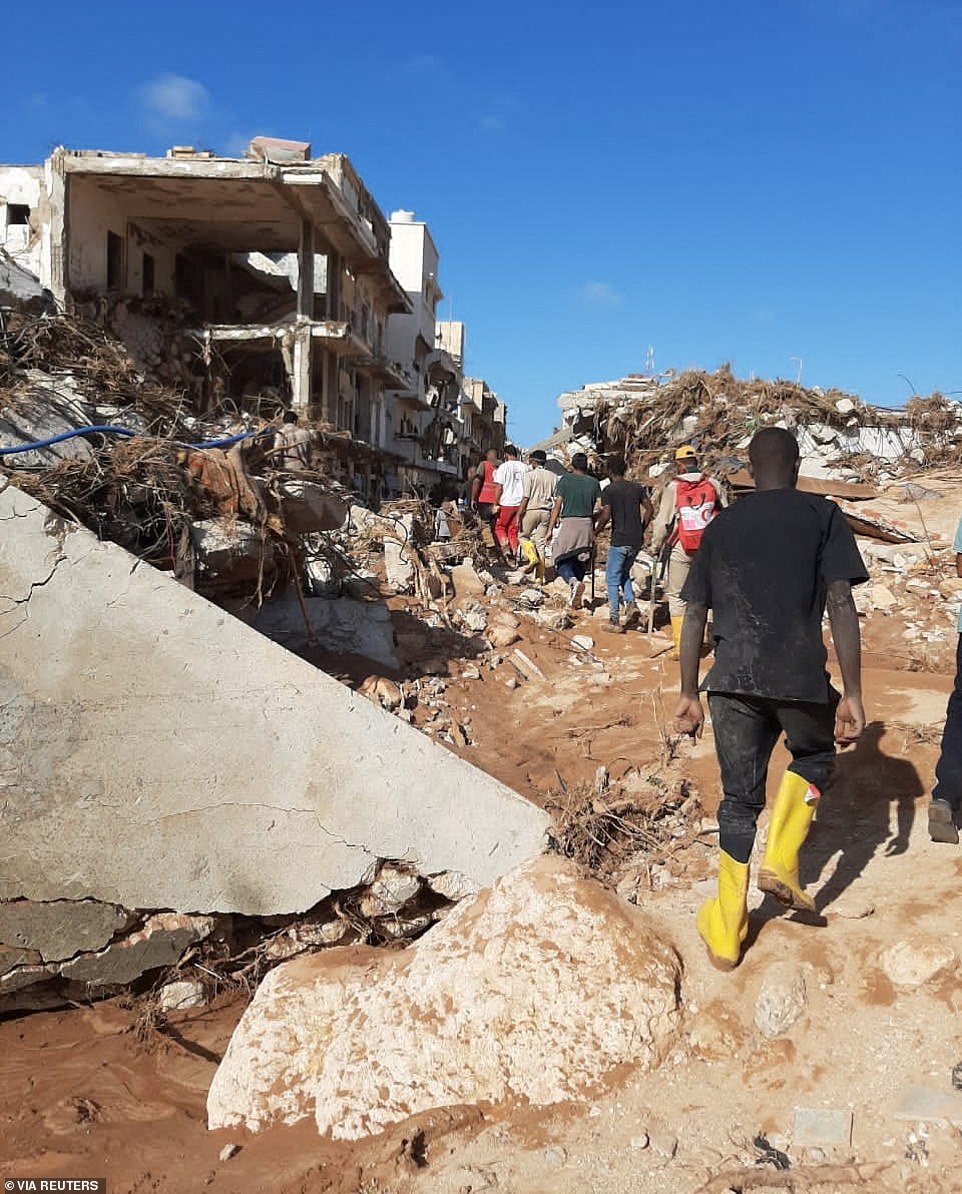
Members of the Libyan Red Crescent Ajdabiya are working in an area affected by flooding. The flood caused massive destruction, leaving Derna’s streets covered in rubble, mud and rubble
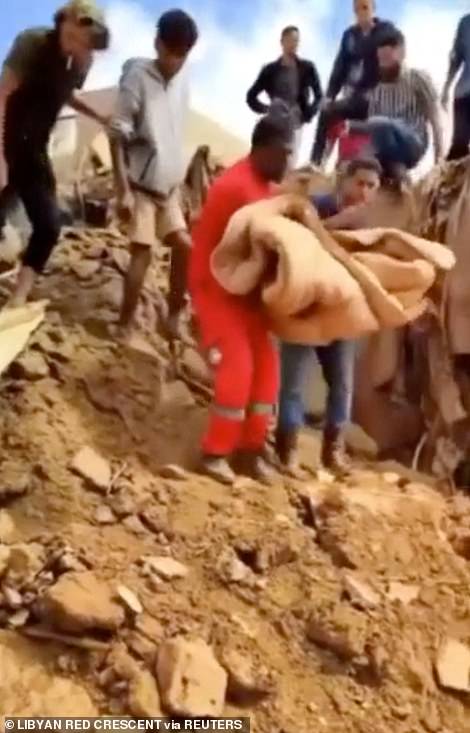
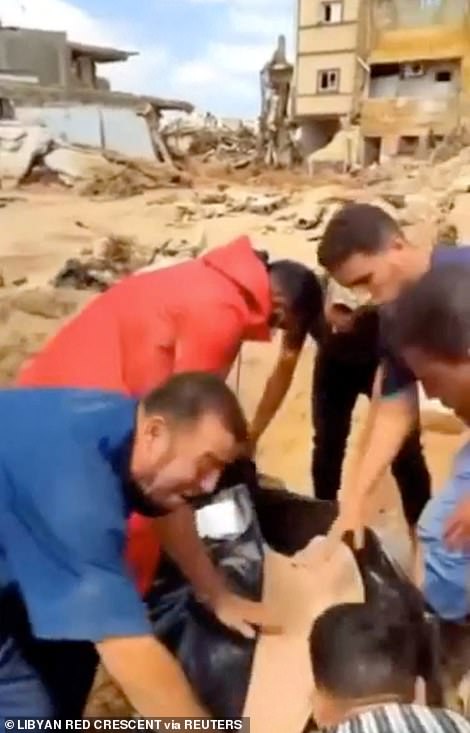
Volunteers from the Libyan Red Crescent were pictured plucking a young child from the rubble as his heartbroken father looked on
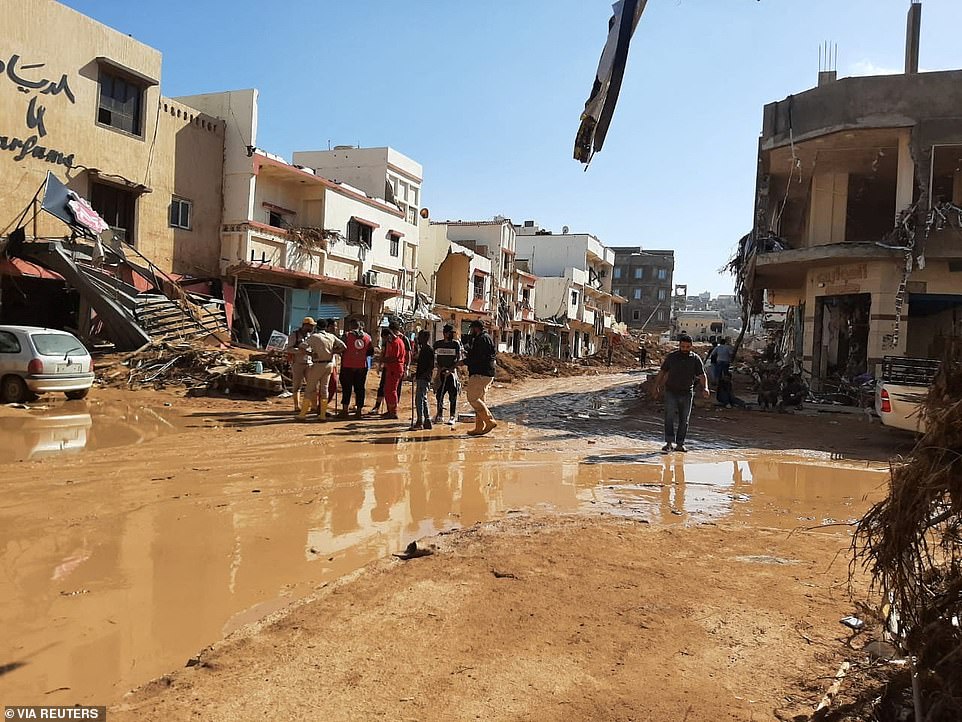
Buildings in Derna were torn apart during the disaster, with photos of the aftermath showing wreckage strewn across the streets
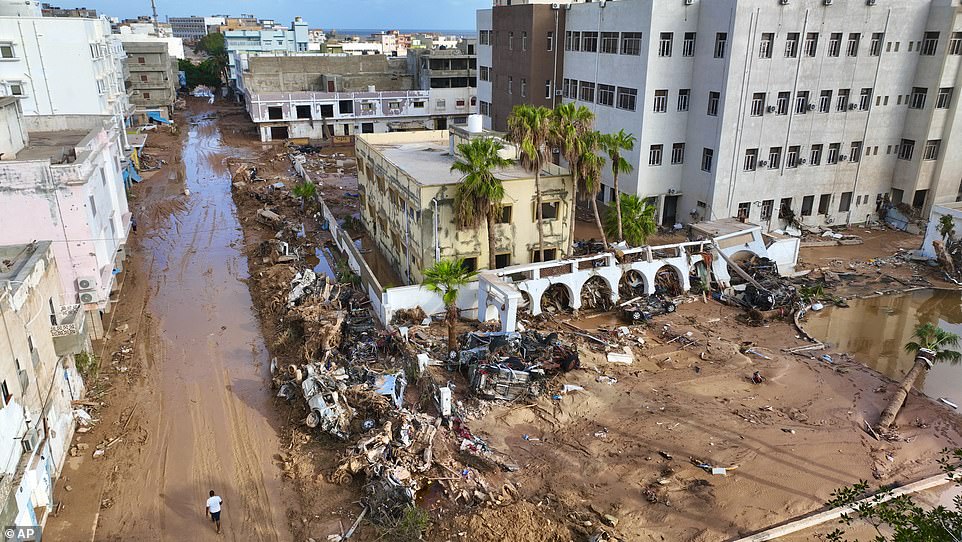
The floodwaters washed away entire buildings and turned the streets in Derna into mud. Mangled cars are among the wreckage left in the wake
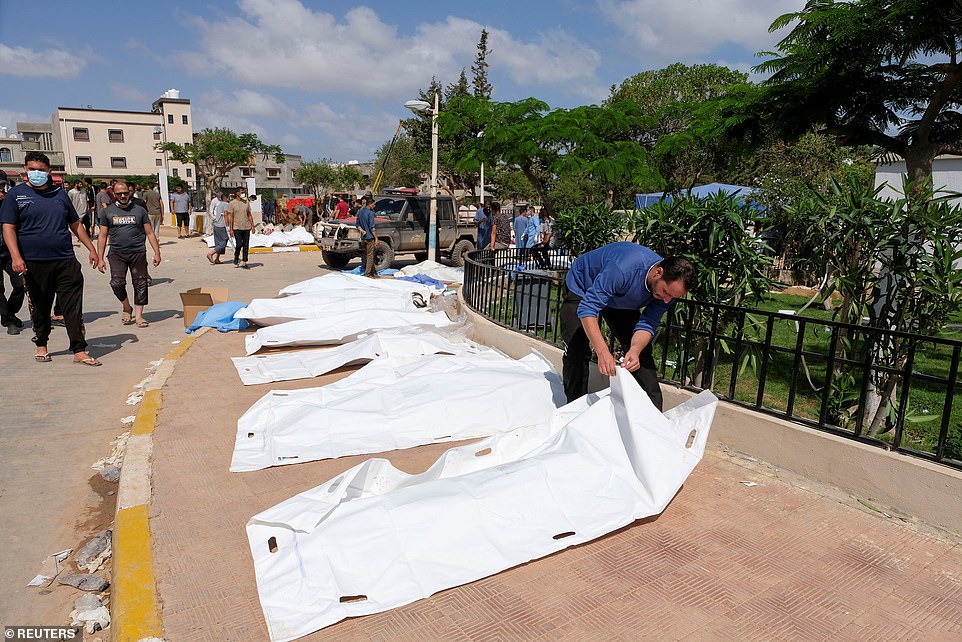
Body bags lie on the streets of Derna, eastern Libya. Thousands have been killed by the floods so far
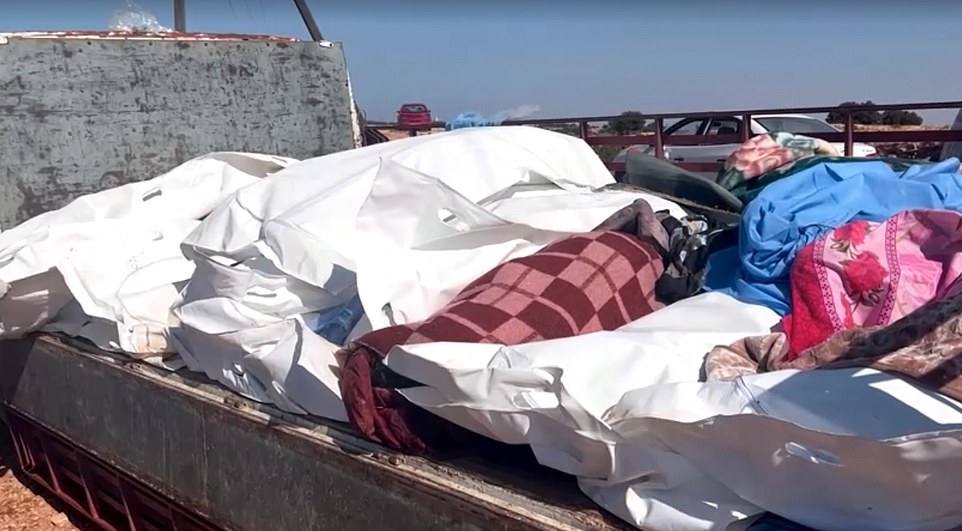
Bodies are laid out so people can identify their relatives before they are buried
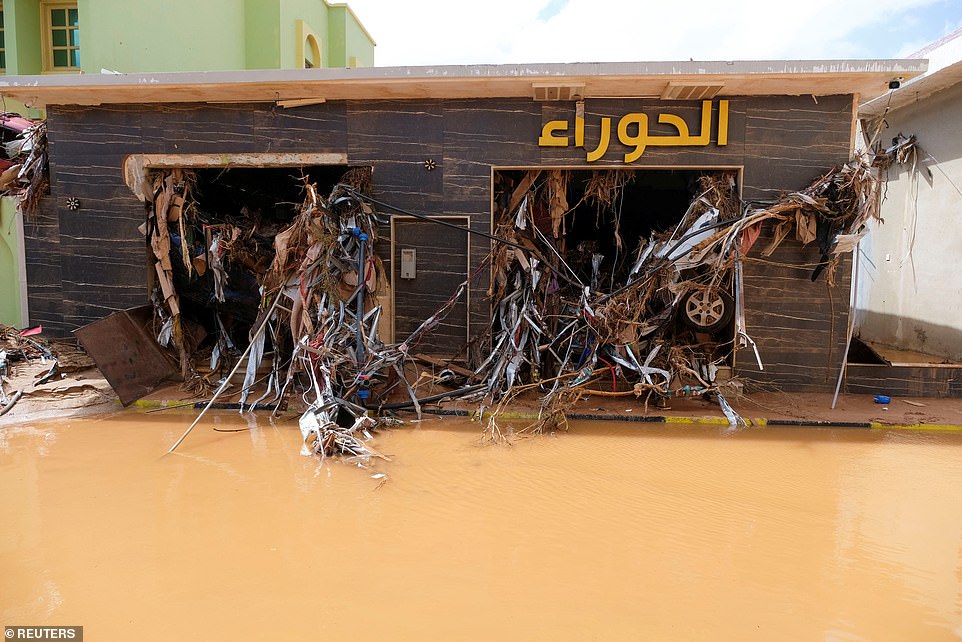
A flooded road in Derna. Car wheels and other debris are scattered across a destroyed building
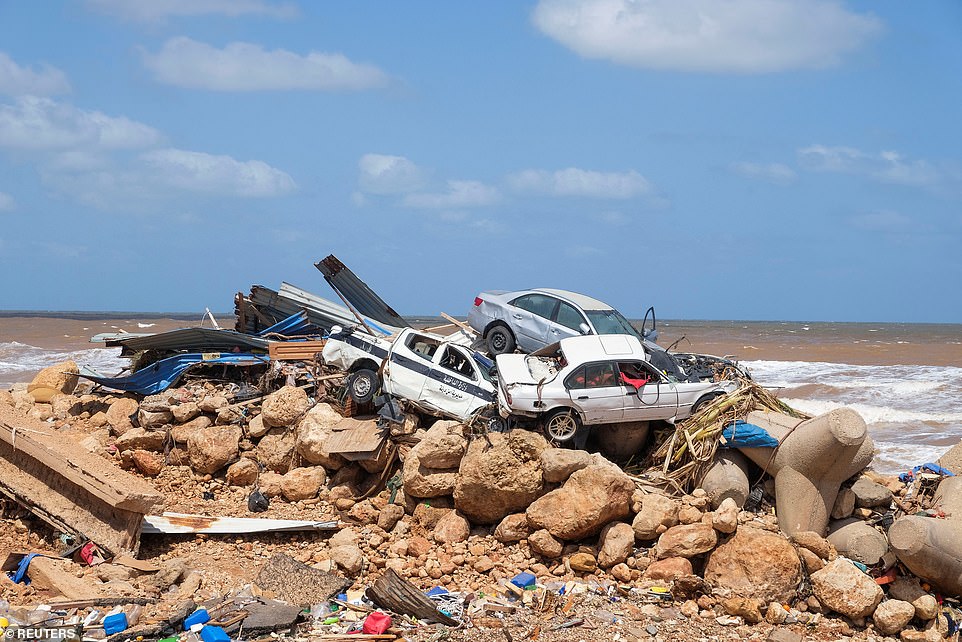
Cars washed out of the city and onto the shoreline. Bodies have been recovered from the sea
The International Organization for Migration (IOM) in Libya said at least 30,000 people had been displaced in Derna alone.
A resident of Derna, Mustafa Salem, said he had lost 30 members of his family so far.
Aid convoys and trucks with bulldozers drove towards the city on Wednesday.
Bodies have been laid out in hospital corridors so people can identify missing relatives as more dead are brought in.
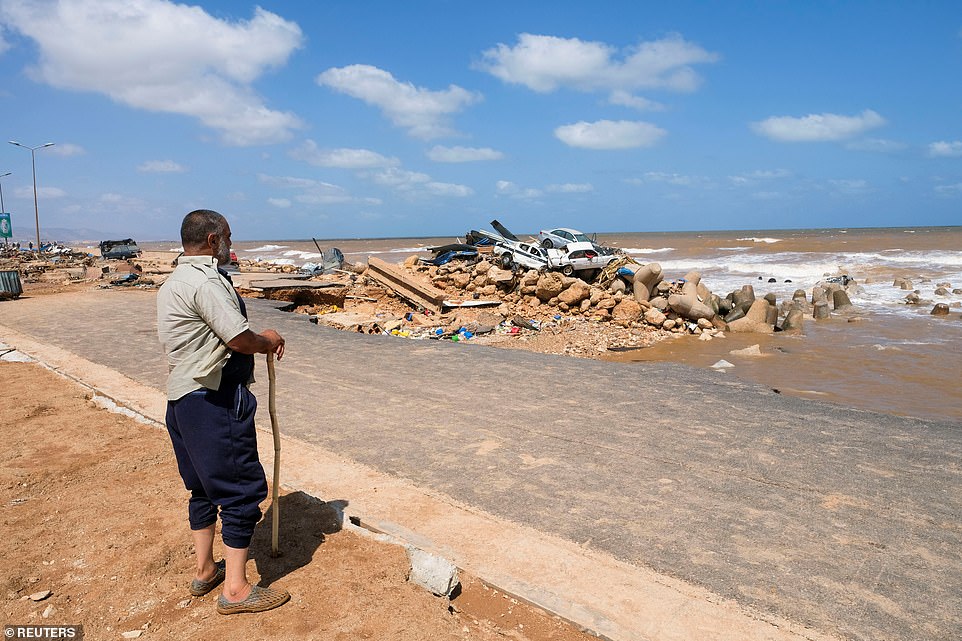
A resident looks at the pile of damaged cars stranded on the Derna coastline after a powerful storm and heavy rain.
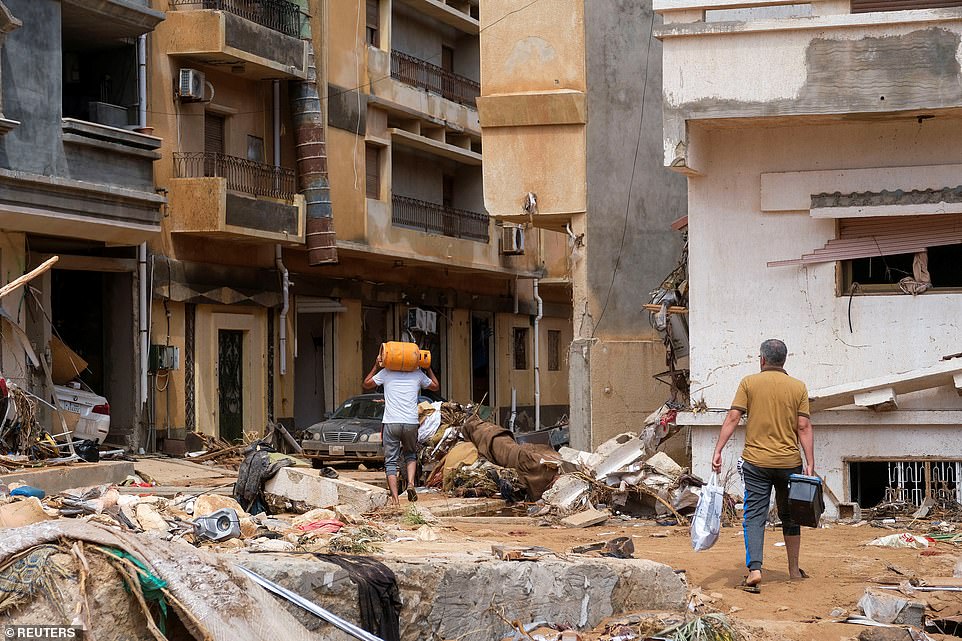
Men carry supplies through the ruins of the city, with rubble littering the streets after this week’s powerful storm and flooding
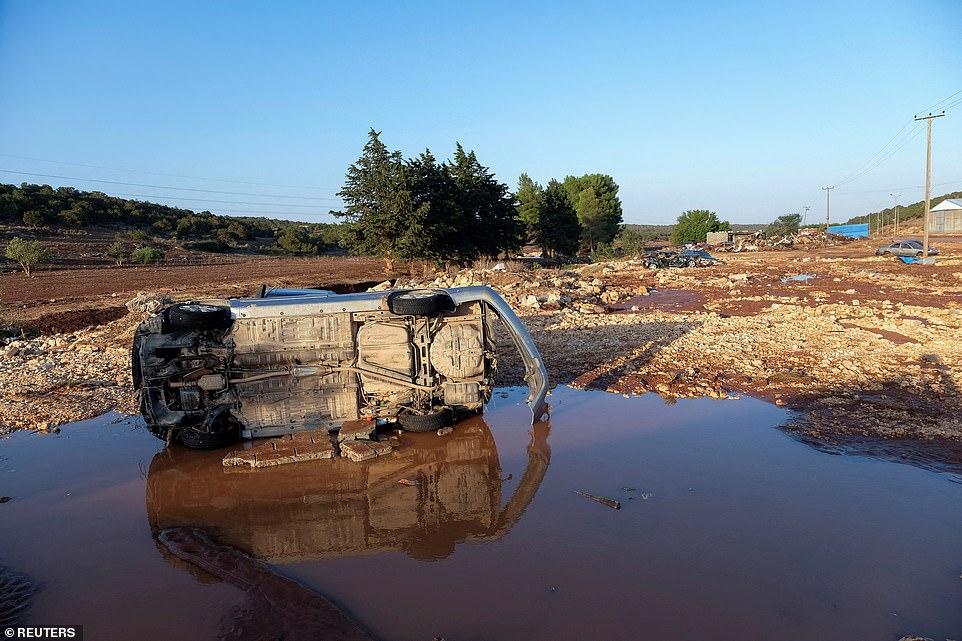
Rural areas outside the city were also hit hard. Cars were flipped and farmland destroyed, photos of the aftermath can be seen
A hospital director said Monday that 1,700 bodies had been counted in his hospital and another 500 had been buried in another part of the city.
Rescue operations are made more difficult because Libya is politically divided.
The internationally recognized Government of National Unity (GNU) is based in Tripoli, in the west.
Derna is located in an eastern area where a parallel administration operates and where control is exercised by the Libyan National Army of commander Khalifa Haftar.
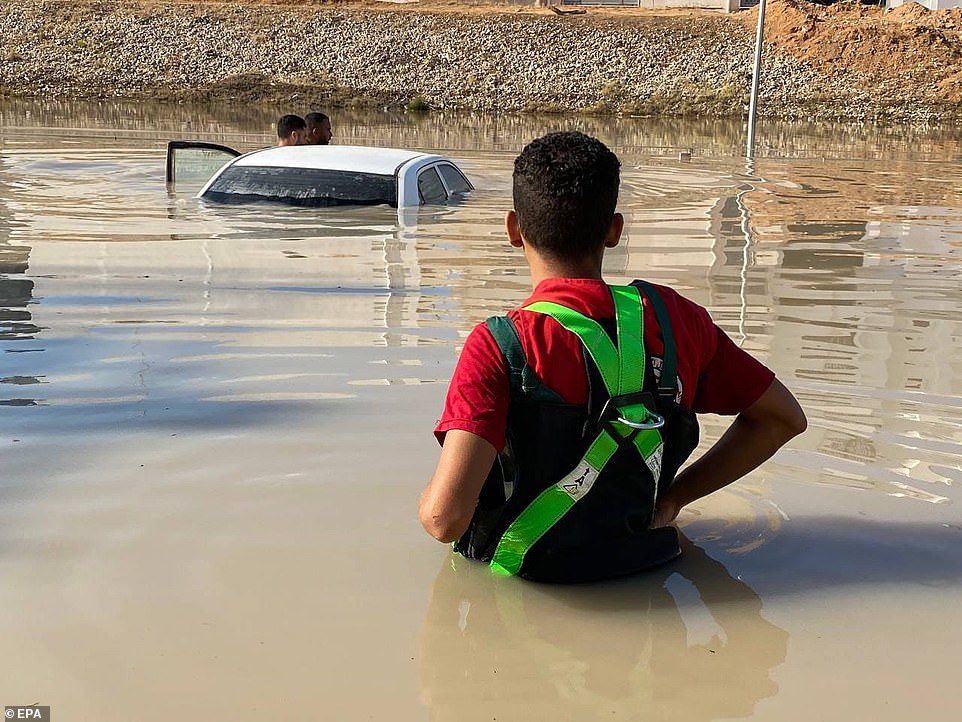
A rescue worker stands in high water next to a completely submerged car. It has been three days since the devastating floods that hit eastern Libya with the most force
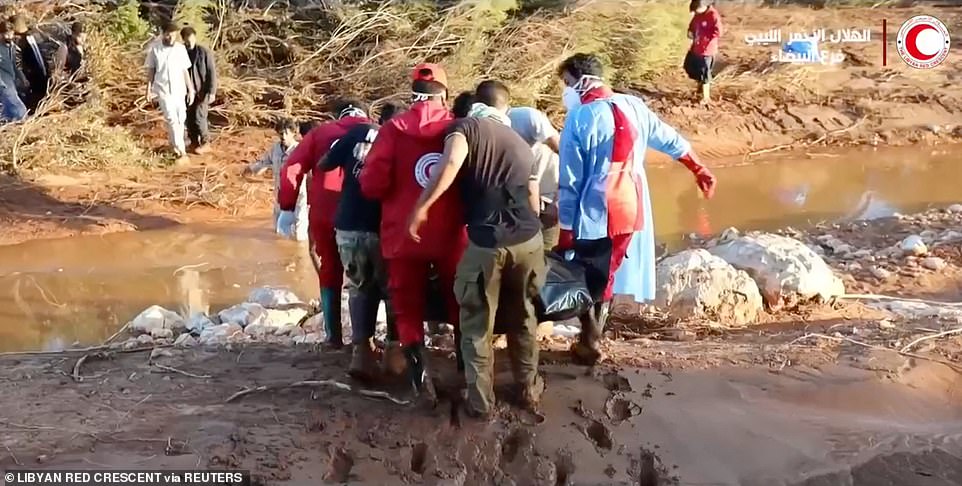
Libyan Red Crescent volunteers take part in a rescue operation, in the aftermath of a powerful storm and heavy rains that hit Libya
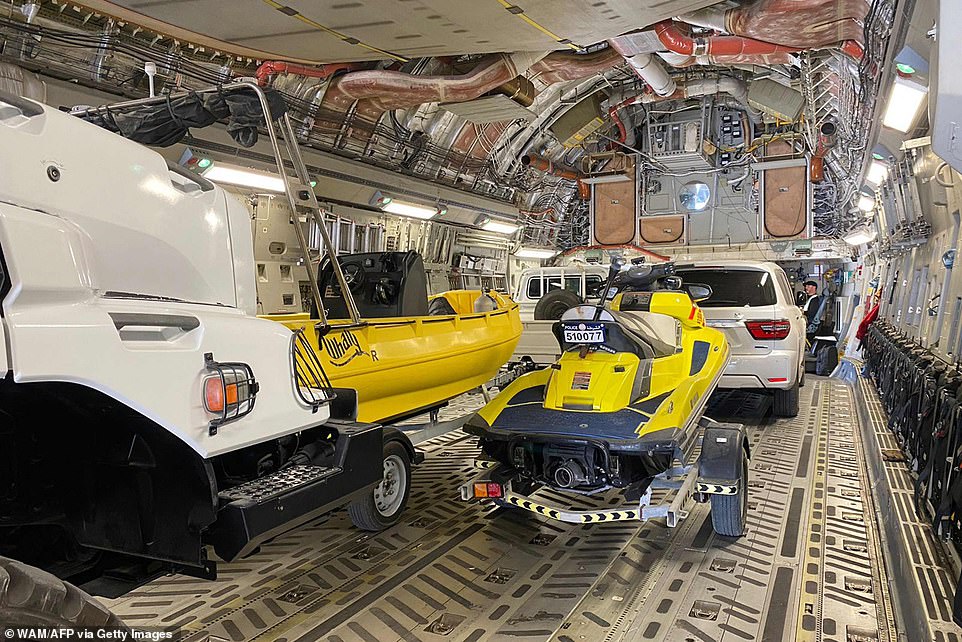
An Emirates Red Crescent relief plane lands in Libya’s eastern second city of Benghazi with water vessels on board as reports say bodies have been found at sea
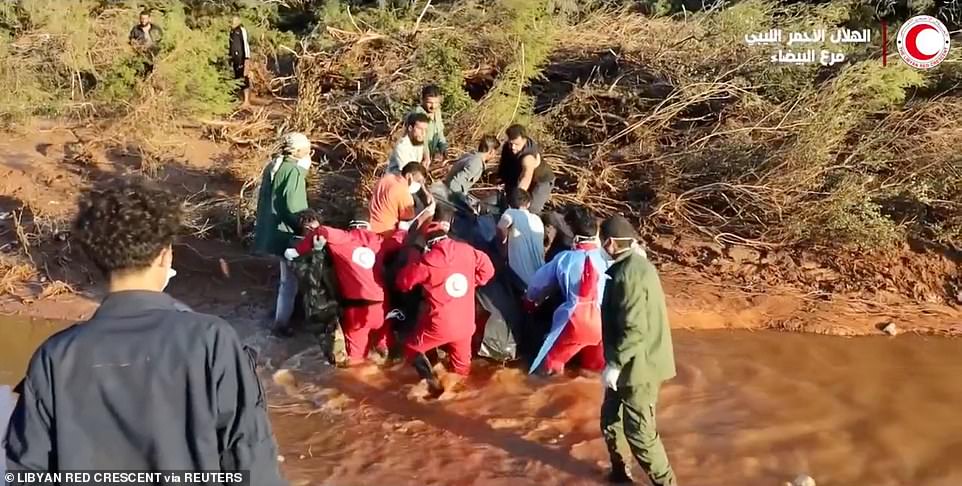
Libyan Red Crescent volunteers wade through high tides as they take part in a rescue operation
Libyan Prime Minister Abdulhamid al-Dbeibah, head of the Tripoli-based government, said on Tuesday that the floods were an unprecedented catastrophe.
The head of Libya’s presidential council, Mohammed al-Menfi, has called for national unity.
The UN Office for the Coordination of Humanitarian Affairs said emergency response teams had been mobilized to help on the ground. Governments including Qatar and Turkey have rushed to aid Libya.
NGO Islamic Relief said in a statement: ‘North Africa has suffered two devastating disasters in just a few days following the earthquake in Morocco, where Islamic Relief has sent an emergency response team.’


